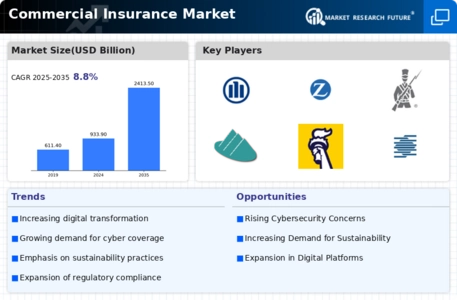The Commercial Insurance Market is currently characterized by a dynamic competitive landscape, driven by factors such as technological advancements, regulatory changes, and evolving customer expectations. Major players like Chubb (US), AIG (US), and Allianz (DE) are strategically positioning themselves through innovation and digital transformation. Chubb (US) has focused on enhancing its digital capabilities to streamline underwriting processes, while AIG (US) has been investing in data analytics to better assess risk and tailor products. Allianz (DE), on the other hand, is emphasizing sustainability in its offerings, which reflects a growing trend among insurers to align with environmental, social, and governance (ESG) criteria. Collectively, these strategies are reshaping the competitive environment, as companies strive to differentiate themselves in a market that is increasingly reliant on technology and customer-centric solutions.
In terms of business tactics, companies are localizing their operations and optimizing supply chains to enhance efficiency and responsiveness. The Commercial Insurance Market appears moderately fragmented, with a mix of large multinational corporations and smaller niche players. The collective influence of key players is significant, as they not only set industry standards but also drive innovation through competitive pressures. This competitive structure encourages continuous improvement and adaptation among all market participants, fostering a climate of innovation and responsiveness to market demands.
In August 2025, Chubb (US) announced a partnership with a leading technology firm to develop an AI-driven risk assessment tool aimed at small and medium-sized enterprises (SMEs). This strategic move is likely to enhance Chubb's ability to provide tailored insurance solutions, thereby increasing its market share in the SME segment. By leveraging AI, Chubb can streamline its underwriting process, reduce costs, and improve customer satisfaction, which is crucial in a competitive landscape where speed and efficiency are paramount.
In September 2025, AIG (US) launched a new suite of cyber insurance products designed to address the growing threat of cyberattacks. This initiative reflects AIG's commitment to innovation and its recognition of the increasing importance of cybersecurity in the commercial insurance sector. By expanding its product offerings in this area, AIG positions itself as a leader in a niche that is becoming increasingly critical for businesses of all sizes, thus enhancing its competitive edge.
In July 2025, Allianz (DE) unveiled its new sustainability-focused insurance products, which are designed to support businesses in their transition to greener practices. This strategic initiative not only aligns with global sustainability trends but also positions Allianz as a forward-thinking insurer that prioritizes environmental responsibility. By integrating sustainability into its core offerings, Allianz is likely to attract a growing segment of environmentally conscious clients, thereby enhancing its market position.
As of October 2025, the Commercial Insurance Market is witnessing significant trends such as digitalization, sustainability, and the integration of artificial intelligence. These trends are reshaping the competitive landscape, as companies increasingly form strategic alliances to enhance their technological capabilities and market reach. The shift from price-based competition to a focus on innovation, technology, and supply chain reliability is becoming evident. Moving forward, competitive differentiation will likely hinge on the ability to leverage technology and sustainability initiatives, as insurers seek to meet the evolving needs of their clients in a rapidly changing environment.


















Leave a Comment